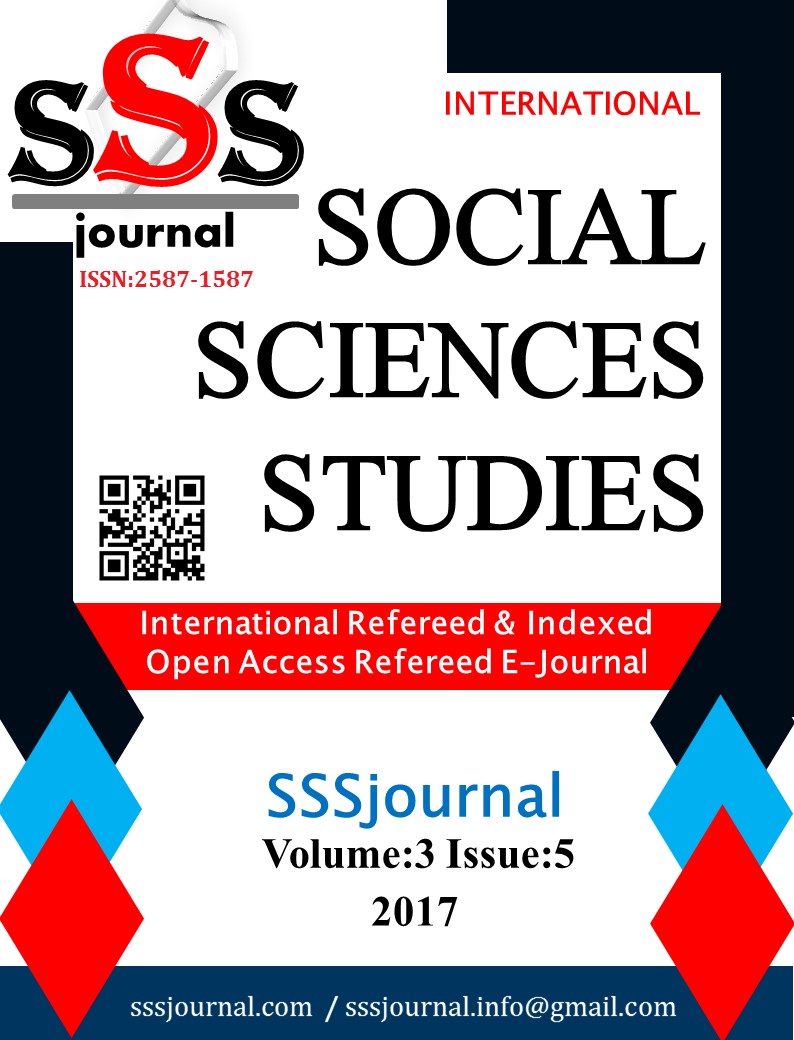Author :
Abstract
Göç ülkemizde yaşanan en önemli sorunlardan biridir. Bu sorun göç alan kentlerin gereğinden fazla büyümesine, göç veren kentlerin de daha çok küçülmesine neden olmaktadır. Bu durum kent sosyolojisi ve ekonomisini olumsuz bir şekilde etkilemekte ve ülke ekonomisine bir maliyet olarak geri dönmektedir. Nihayetinde yaşanan küçülme kentlerin işlevsiz hale gelmesine yol açmaktadır. Bu çerçevede, göç etme eğiliminin araştırılması büyük bir önem arz etmektedir. Bu amaçla göç veren bir kent olan Bayburt’un Aydıntepe ilçesinde göç etme eğilimi ekonomik sıkıntıların nispeten yoğun olduğu 2010 yılı ve ekonomik sıkıntıların hafiflediği 2017 yılı karşılaştırmalı olarak incelenmiştir. Tarama araştırmasında göç etme nedenini olarak işsizliği gösterenlerin oranı 2010 yılı araştırmasında % 100 iken bu oran 2017 yılında % 67’ye kadar gerilemiştir. Göç gerek ekonomik sıkıntıların yaşandığı dönemde gerekse bu sıkıntıların hafiflediği dönemlerde temelde işsizlik kaynaklı olmakla birlikte, ekonomik sıkıntıların nispeten hafiflediği 2017 yılındaki tarama araştırmasında sosyo-kültürel yetersizlikler nedeniyle göç etmek isteyenlerin oranı % 6’dan % 56’ya çıkması kentin sunduğu sosyo-kültürel imkânların da göçe etkide bulunduğunu göstermektedir. Yapılan analizde, kentler arası göçün en aza indirilmesi için kentsel mekanın hem ekonomik hem de sosyo-kültürel imkanlar yönünden kent sakinleri için yeterli hale getirilmesi gerektiği sonucuna ulaşılmaktadır.
Keywords
Abstract
Migration is one of the most important problems in our country. This problem causes the cities that receive immigration to grow excessively and the cities that emigrate to become even smaller than necessary. This negatively affects urban sociology and the economy and returns as a cost to the country's economy. Eventually, the downsizing that is happening leads the cities to become dysfunctional. In this framework, it is of great importance to investigate the tendency to migrate. For this purpose Bayburt, an immigrant city, tended to migrate in the district of Aydin, comparatively examining the year 2010, when the economic troubles were relatively intense and the year 2017, when the economic troubles were alleviated. Migration tendency in the screening survey is 100% unemployment in the 2010 survey. This rate declined to 67% in 2017. In the period of economic difficulties, migration is mainly due to unemployment in these periods, while the rate of those who want to migrate due to socio-cultural deficiencies is increasing from 6% to 56% in the screening survey of the year 2017 when the economic troubles are relatively mild, socio-cultural opportunities It shows that the mound is in effect. In the analysis, it is reached that urban space should be sufficient for urban dwellers in terms of both economic and socio-cultural possibilities in order to reduce most of the migration between cities
Keywords
- Başel, H. (2009). Sivas'tan Göç ve Göç Edenlerin Sosyo–Ekonomik Nitelikleri – I. Sosyal Siyaset
- Başel, H. (2009). Sivas'tan Göç ve Göç Edenlerin Sosyo–Ekonomik Nitelikleri – I. Sosyal Siyaset Konferansları Dergisi, 365-391.
- Başkaya, Z., & Gök, Y. (2013). Osmaneli İlçesinde Göç. Doğu Coğrafya Dergisi, 105-128.
- Bayramoğlu, T. (2015). Biyokütle Enerjisi Isıtma Amaçlı Fosil Yakıtlara Alternatif Olabilir mi?TRA1 Bölgesi Üzerine Tanımsal Bir Analiz. Fırat Üniversitesi Sosyal Bilimler Dergisi, 25(1), 163- 174.
- Bayramoğlu, T., & Durmaz, A. (2017). Sustainablity in Economics. E. E. Başar, & T. Bayramoğluiçinde, Studies on Sustainability Research (s. 75-86). Saarbrücken, Germany: Lambert Acedemic Publishing.
- Cole, S. (1999). Sosyolojik Düşünme Yöntemi (Sosyoloji Bilimine Giriş). (B. Demirkol, Çev.) Ankara: Vadi Yayınları.
- Genç, M. (2010). Osmanlı İmparatorluğunda Devlet ve Ekonomi. İstanbul: Ötüken Yayınları.
- İbret, B. Ü. (2010). Kastamonu'nun Göç Olgusu. Coğrafya Dergisi İstanbul Üniversitesi Edebiyat Fakültesi Coğrafya Bölümü(20), 34-47.
- Karahan, H. (2006). Bursa İli Harmancık İlçesinin Sosyo-Ekonomik Yapısı ve Göç Sorununun İncelenmesi . Bursa: Yayınlanmamış Yüksek Lisans Tezi.
- Kaygalak, S. (2009). Kentin Mültecileri. Ankara: Dipnot Yayınları.Keleş, R. (2008). Kentleşme Politikası. Ankara: İmge Kitabevi.
- Korkut, F. (2007). Psikolojik Danışmanların Mesleki Rehberlik ve Psikolojik Danışmanlık İle İlgili Düşünceleri ve Uygulamaları . Hacettepe Üniversitesi Eğitim Fakültesi Dergisi, 187-197.
- Massey, D. S., Arango, J., Hugo, G., Kouaouci, A., Pellegrino, A., & Taylor, J. E. (2014). Uluslararası Göç Kuramlarının Bir Değerlendirmesi. Göç Dergisi, 1(1), 11-46. 04 09, 2017 tarihinde alındı
- Miroğlu, İ. (1975). XVI: Yüzyılda Bayburt Sancağı. İstanbul: Anadolu Yakası Bayburt Kültür ve Yardımlaşma Derneği Yayınları.
- Neuman, W. L. (2014). Toplumsal Araştırma Yöntemleri (Cilt I). (S. Özge, Çev.) Ankara: YayınOdası Yayıncılık.
- Özerin, G. (1996). Kırdan Kente Göç Eğilimleri Üzerine Bir Araştırma: Denizli İli Örneği. Gaziosmanpaşa Ziraat Fakültesi Dergisi, 135-160.
- Özger, Y. (2015). Bayburt Nüfus Defterleri. Bayburt: Bayburt Üniversitesi Yayınları."
- Özger, Y. D. (2008). IX. Yüzyıl Bayburt (Sosyo-Ekonomik, İdari ve Demografik Yapı). İstanbul: IQ Kültür Sanat Yayıncılık.
- Öztürk, C. H. (2006). Bayburt İlinde Gelir Düzeyinin Göçe Etkisi. İstanbul: Yayınlanmamış Yüksek Lisans Tezi.
- Polat, T. (Winter 2016). Sürdürülebilir Kentleşme Politikaları ve Türkiye. Electronic Turkish Studies, 11(2), 1267-1300.
- Sağlam, S. (2006). Türkiye'de İç Göç Olgusu ve Kentleşme. Türkiyat Araştırmaları(5), 33-44. Sirkeci, İ., & Yüceşahin, M. (2014). Türkiye'de Göç Çalışmaları. Göç Dergisi, 1-10.
- Taşğın, G. (2009). Erzurum İli Oltu İlçesinin Kırsal Kalkınma Potansiyeli ve Göç Sorunu. Erzurum: Yayınlanmamış Yüksek Lisans Tezi.
- Tekeli, İ. (2008). Türkiyenin Göç Tarihinde Değişik Kategoriler. İ. Tekeli içinde, Göç ve Ötesi (s. 42-67). İstanbul: Tarih Vakfı Yurt Yayınları.
- Tekeli, İ. (2008). Türkiye'nin Yaşadığı Hızlı Kentleşmenin Öyküsünü Modernist MeşruiyetKavramını Merkeze Alarak Kurmak . İ. Tekeli içinde, Göç ve Ötesi (s. 240). Ankara: Tarih Vakfı Yurt Yayınları.
- TUİK. (tarih yok). http://www.tuik.gov.tr/UstMenu.do?metod=temelist. 03 30, 2017 tarihinde www.tuik.gov.tr. adresinden alındı
- Yapraklı, S., & Bayramoğlu, T. (2014). Biyokütle Enerjisi Potansiyeli ve Ekonomik Etkileri: TRA1Bölgesi Üzerine Bir Saha Araştırması. Atatürk Üniversitesi Sosyal Bilimler Enstitüsü Dergisi, 319- 336.
- Yıldırmaz, S. (2010). Kente Yönelen Köylüler: Kırsal Yapının Dönüşümü, Göç ve gecekondu,. (B. Şen, & Doğan Ali Ekber, Dü) Ankara: Dipnot yayınları.
- http://www.tuik.gov.tr/PreTablo.do%3Falt_id%3D1059 (05.04.2017 tarihinde erişildi.)
- http://report.tuik.gov.tr/reports/rwesevlet?adnksdb2=&report=turkiye_ilce_koy_sehir.RDF&p_ill=6 9&pilcel=1767&p_kod=2&p_yil2009&p_dil=1&desformat=html&ENVID=adnksdb2Env
- www.tuik.gov.tr/PreIstatistikTablo.do?istab_id=220 (06.10.2016)
- http://www.tuik.gov.tr/PreTablo.do%3Falt_id%3D1059 (05.04.2017)





